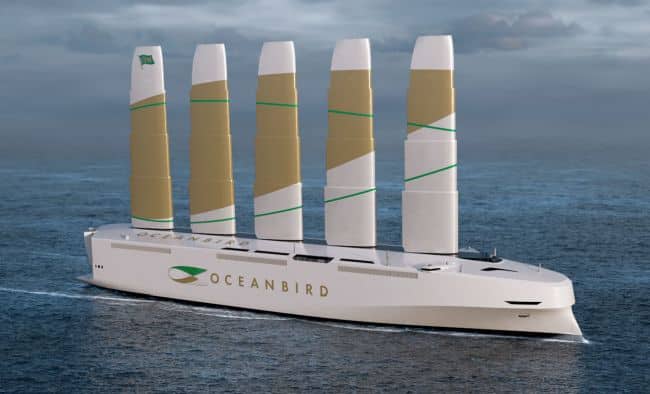At a live webcast 10 September 2020, Oceanbird – the world’s first wind powered PCTC concept was introduced. Oceanbird will revolutionize transportation by sea – powered by wind with reduced emissions by 90%.
Innovative Swedish technology
- Height over water line: 105 metres
- Average speed: 10 knots
- Displacement: 32,000 tonnes
- Length: 200 metres
Thousands of years have passed since we learnt to harness the wind so that ocean-going vessels could travel faster and further. The wind helped us discover our planet – now it can help us preserve it.
Innovative Swedish technology will make it possible to power the largest ocean-going vessels by wind, reducing emissions by 90 percent. Sails are no longer the issue – this time the rigging has more in common with airplane wings. Oceanbird is about revolutionizing technology that will put an end to the era of fossil-driven cargo ships in maritime transport. The wind is back.
Or, to be more precise, the wind has always been there, but no one has been able to use it to power a cargo ship crossing the Atlantic with 7,000 cars in its hull. Until now.
When the first ship makes its maiden voyage, it will be a historical occasion for maritime transport.
The international seafaring organization IMO has set a goal of reducing carbon dioxide emissions from international shipping by 40 percent by 2030. Oceanbird will contribute to changing, updating, and remodeling an entire industry.
The wind helped us discover our planet – now it can help us preserve it
- 7,000 cars can be carried in the cargo hold
- 90% lower emissions than a vessel with a diesel engine
- 5 rigs with 80 metres tall wing sails for forward propulsion
- 12 days to cross the Atlantic with the wind as energy source
The 200 metres long and 40 metres wide cargo vessel will be able to cross the Atlantic in 12 days. The wing sails are all of 80 metres tall, giving the ship a height above water line of appr. 105 metres, but thanks to a telescopic construction they can be lowered, resulting in a vessel height above water line of appr. 45 metres.
This comes in handy when passing under bridges or if the surface area of the wingsails needs to be reduced due to strong winds. To be able to get in and out of harbours – and as a safety measure – the vessel will also be equipped with an auxiliary engine. Powered by clean energy, of course. The first vessel will be a cargo ship, but the concept can be applied to ships of all types, such as cruise ships.
Towards truly sustainable shipping
Traditions can be forward-looking – if said traditions are progress and innovation. Ever since Olof Wallenius founded Wallenius in 1934 the company has had a long-term focus on sustainability, regarding technological innovation as well as working conditions for the crew.
With Oceanbird we are taking a great step closer to our vision of emission-free shipping, while at the same time setting a new standard for the entire industry.
Moving an industry
Progress takes place in small steps as well as great leaps. Oceanbird is progress by small steps forward in existing knowledge and technology – but also a great leap forward regarding how ideas and know-how from different areas can enrich one another.
The result is a technology shift that shows how an entire industry can readjust to sustainable transports.
Source:- Marine Insight






